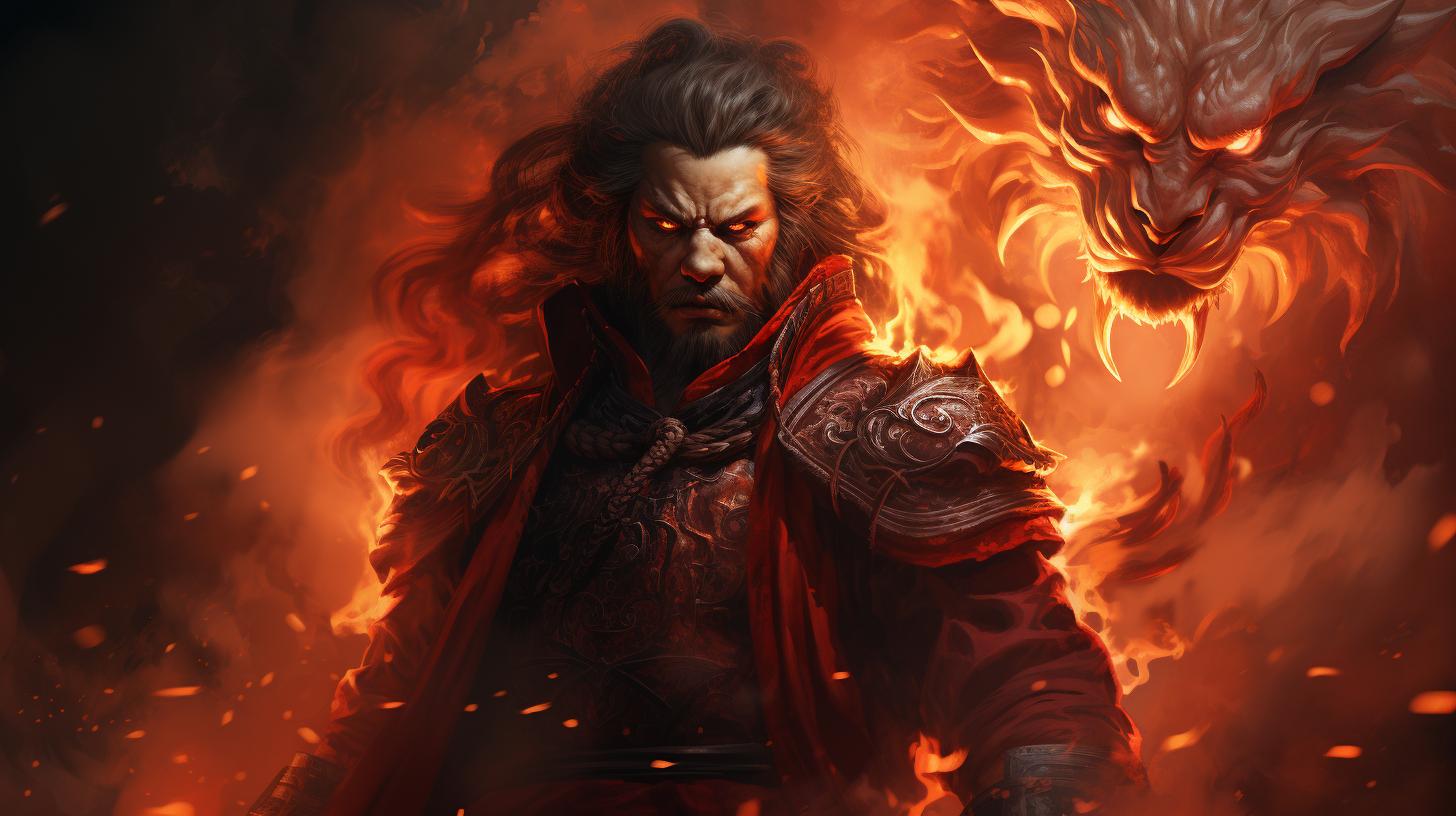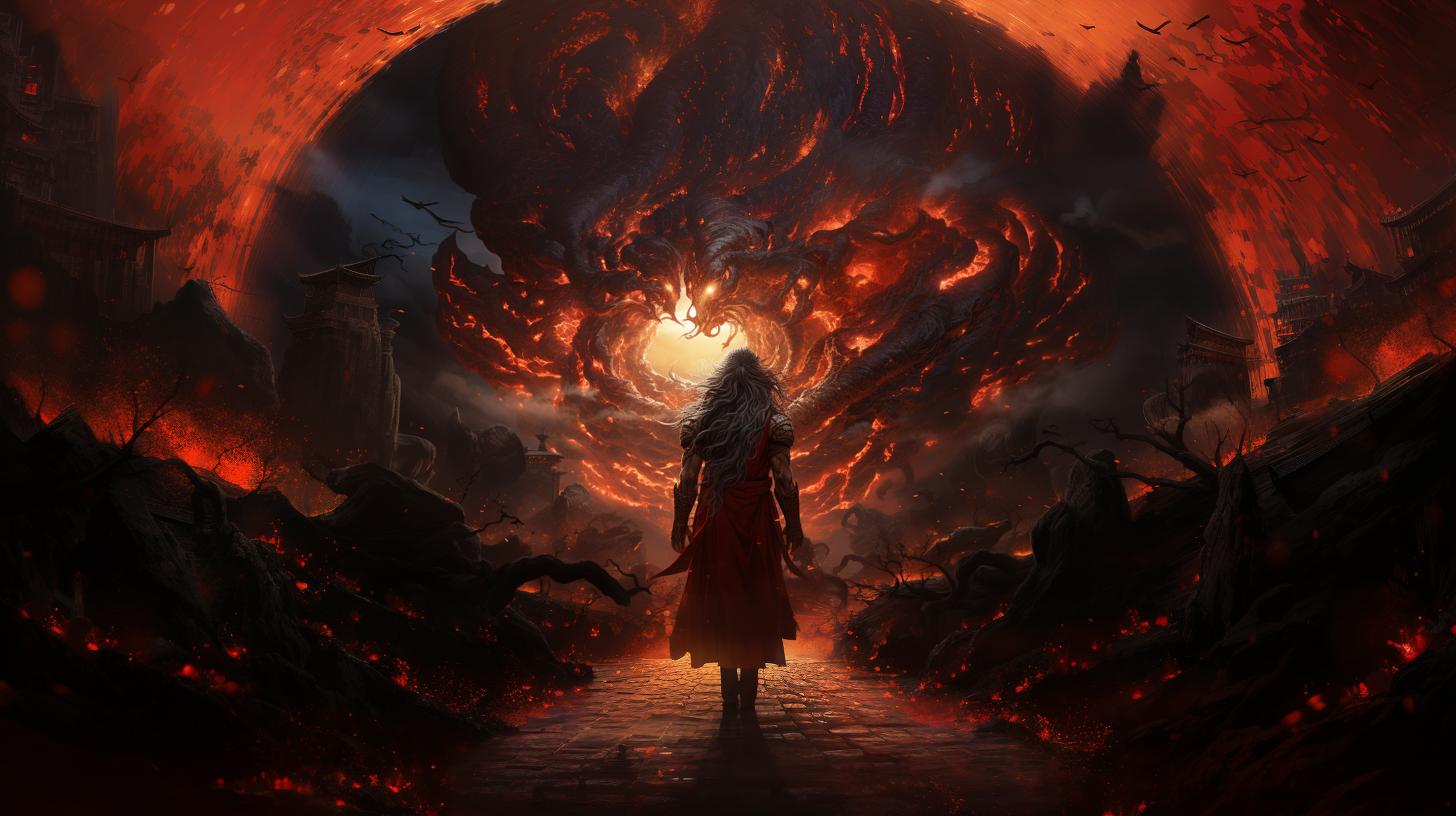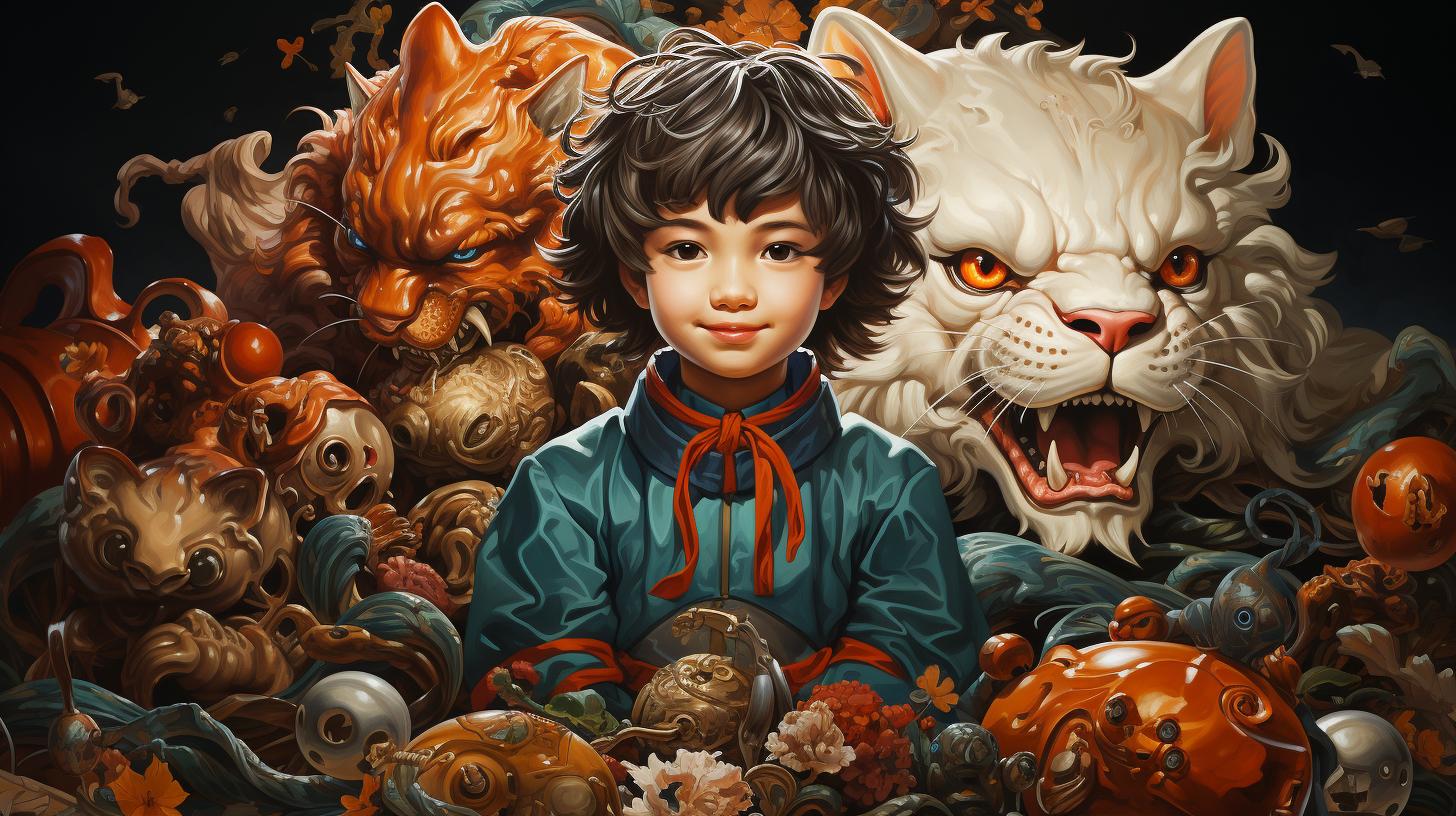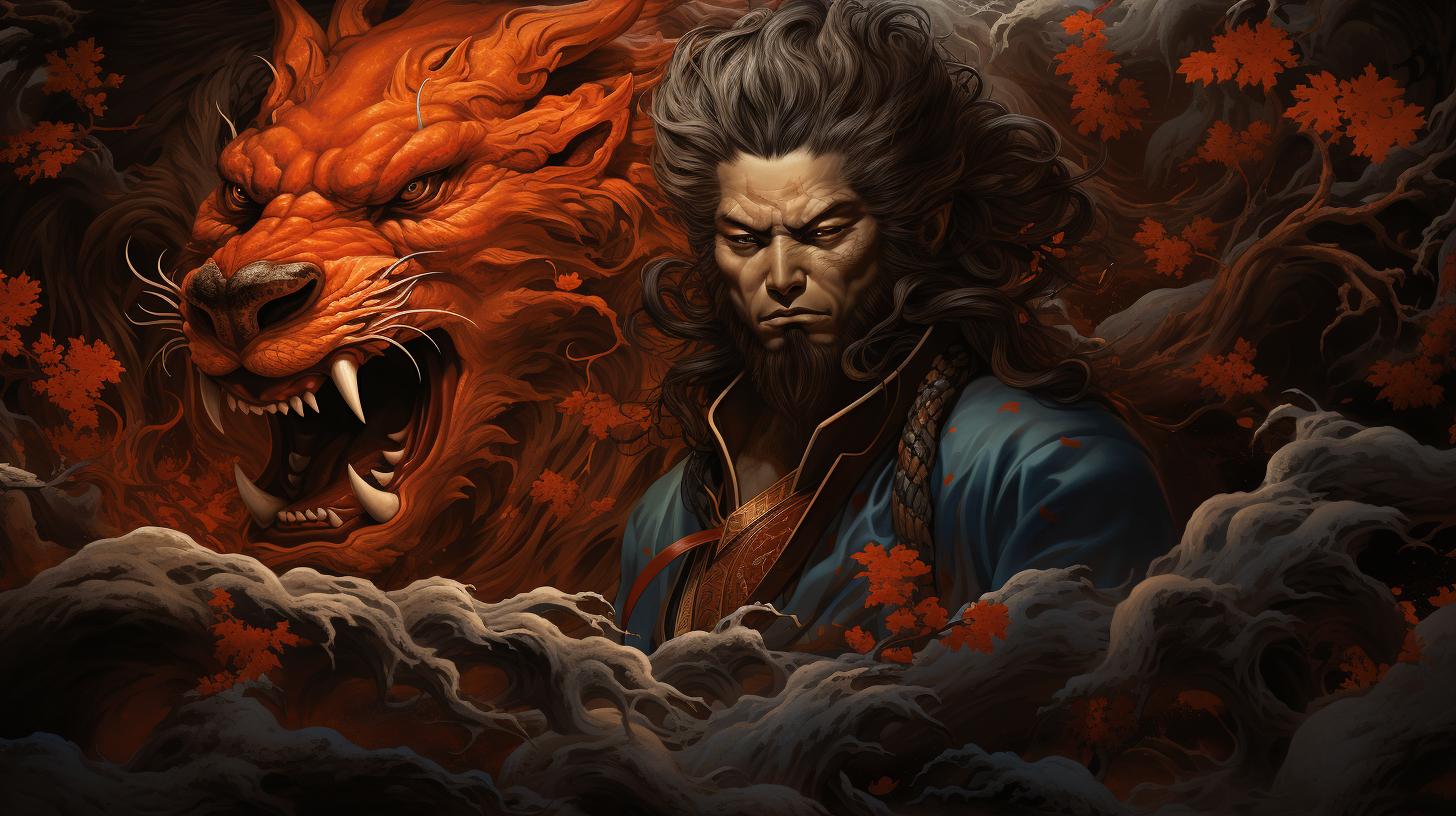Kagutsuchi: The Japanese God of Fire and Destruction

Kagutsuchi, the Japanese god of fire, is a revered deity in Japanese mythology who is associated with creation, destruction, and volcanism. Legends state that his birth caused the death of his mother, Izanami, and his father, Izanagi, was forced to kill him.
Despite his destructive nature, Kagutsuchi was revered by artisans who worked with fire, such as blacksmiths and potters. His influence can be seen in Japanese weapons and crafts, as well as modern media such as manga and video games.
Mythology
Kagutsuchi, the Japanese god of fire, has a prominent role in Japanese mythology and is associated with destruction and creation. His birth is a particularly significant event in his mythology.
The Birth of Kagutsuchi
The story of Kagutsuchi’s birth portrays him as a powerful and uncontrollable deity. According to legend, Kagutsuchi was born during his mother Izanami‘s final moments of life. His fiery birth caused severe burns and ultimately killed Izanami. Kagutsuchi’s father, Izanagi, was furious and chopped off his son’s head, resulting in the creation of several other gods.
This violent and destructive event set the tone for Kagutsuchi’s mythology and his association with the powerful and uncontrollable force of fire.
Kagutsuchi’s Role in Japanese Mythology
Kagutsuchi’s main role in Japanese mythology revolves around his association with fire and its ability to create and destroy. He is often associated with volcanoes and earthquakes, which were seen as manifestations of his power.
Japanese mythology often portrays Kagutsuchi as a force of chaos and destruction, and he was often feared and revered by the population.
Other Gods Associated with Kagutsuchi
It is common for deities in Japanese mythology to be associated with other gods and goddesses, and Kagutsuchi is no exception. He is often associated with other deities such as Amaterasu, the goddess of the sun, and Susanoo, the god of storms and the sea.
The story of his birth also resulted in the creation of several other gods.
History and Significance
The history and significance of Kagutsuchi in Japanese culture is a reflection of the importance of fire in ancient Japan. The god was revered as a powerful force of creation and destruction, as well as a symbol of purification and renewal.
Kagutsuchi in Ancient Japan
According to Japanese mythology, Kagutsuchi was born at the time of the creation of Japan when the gods Izanami and Izanagi gave birth to countless deities. Kagutsuchi, born from the goddess Izanami, was considered a fierce god of fire who burned his mother to death at birth.
His father, the god Izanagi, enraged by his wife’s death, beheaded Kagutsuchi. From his spilled blood, eight deities were born, and Kagutsuchi’s body parts created the mountains and rivers of Japan.
This interpretation explains why Kagutsuchi was considered a god of both creation and destruction.
The Importance of Kagutsuchi in Japanese Culture
Kagutsuchi was an important deity in Japanese culture, particularly for artisans who worked with fire. Japanese metalworkers and swordsmiths regarded him as a patron deity, and many temples were built in his honor.
Kagutsuchi was also worshiped for purification rituals, as fire was seen as a way to cleanse and renew. Japanese mythology highlights the importance of fire in human affairs, and Kagutsuchi was revered as a deity who could both create and destroy, a symbol of both power and unpredictability.
Kagutsuchi’s Influence on Japanese Weapons and Crafts
Kagutsuchi’s importance can be seen in various forms of Japanese art, particularly in weapons and crafts. The deity’s role in metalworking and sword-making was especially significant. Kagutsuchi was associated with the creation of iron and steel, and his fiery nature was said to have imbued swords and knives with power.
Japanese artisans considered it good fortune to work with fire under the protection of Kagutsuchi. The god’s associations with volcanism and seismic activity also contributed to his widespread influence on Japanese culture, particularly in the arts.
In conclusion, the history and significance of Kagutsuchi in Japanese culture is a reflection of Japan’s longstanding relationship with fire, a force that was both revered and feared. Through Kagutsuchi, the Japanese people demonstrate their appreciation for the power and unpredictability of nature, as well as their ability to shape it, as demonstrated by their skilled craftsmanship.
Popular Culture
As a deity associated with fire and destruction, Kagutsuchi has made a significant impact on modern media and popular culture in Japan. From video games to contemporary art, the god of fire’s influence continues to be felt in a range of mediums.
Kagutsuchi in Modern Media
The god of fire has made appearances in a range of modern media, including manga, anime, and films. Kagutsuchi often takes on the appearance of a dragon or a snake in popular culture.
Many of these portrayals emphasize Kagutsuchi’s destructive potential, depicting the deity as a malevolent force capable of causing great harm.
Kagutsuchi in Video Games
- In the popular video game “Okami,” Kagutsuchi is depicted as a powerful dragon that the player must defeat in order to progress through the game.
- In “Persona 4,” Kagutsuchi is summoned as a persona by the character Kanji Tatsumi.
- In “Smite,” an online multiplayer game, Kagutsuchi is a playable character with a range of fire-based attacks.
Kagutsuchi’s Representation in Contemporary Art
Kagutsuchi has been featured in a range of contemporary art forms, including paintings, sculptures, and installations.
Many contemporary artists have focused on the deity’s associations with fire, creating works that incorporate flames, heat, and other aspects of the element. Some artists have also explored the destructive potential of fire, drawing on Kagutsuchi’s mythology to create works that comment on environmental destruction and other contemporary issues.
…




















